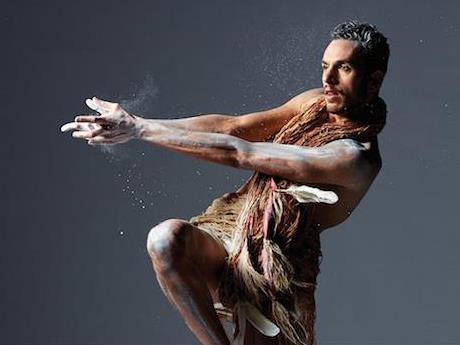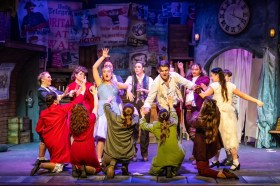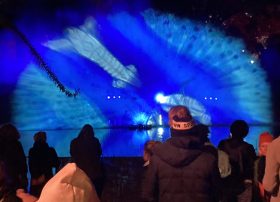The Australia Council study reveals Indigenous artists continue to face disadvantage with both presenters and audiences not including Indigenous work in their thinking.
Mapping of programs by 135 Australian presenters found about 2% of the 6000 works programmed in 2015 seasons was Indigenous. While this is close to the Indigenous percentage of the population (about 2.4%), drilling down these results reveals big differences between presenters.
Two thirds of presenters did not present any work by Aboriginal or Torres Strait Island artists in 2015. The study identified five barriers to presenting Indigenous works:
- financial risk
- difficulty finding suitable works that are not tokenistic
- concerns that Indigenous work is ‘too serious’
- fear of ‘doing First Nations work wrong’
- Australia’s underlying race issues.
Negative audience behaviour was behind much of the difficulty. Audiences like the idea of Indigenous arts but they don’t go. While 92% of audience respondents considered Indigenous arts important to Australian culture, only 24% attended Indigenous arts. Audiences perceived Indigenous art as serious and preachy and many expected it to be traditional, although 80% of Indigenous work shown in 2015 was contemporary.
Presenters said they needed more accessible and entertaining Indigenous works. ‘People, they don’t wanna go, “Oh my god, I’m going to pay money and I’m going to get there and I’m going to be told how guilty I should be for being white.” Nobody wants to do that. That’s not a fun night out!’ one respondent said.
‘You know, there’s got to be a really strong hook for us to get a good audience… Yeah, if Ilbijerri did Cats, I’m sure they would come along!’ said another.
Ironically the artistic power of Indigenous works can be a disadvantage in getting them presented. ‘I thought it was too hard hitting a work for this community. I didn’t have the courage to do it. And I probably should have… It was such a strong, brave, fabulous work,’ one presenter said of the decision not to program an Indigenous work.
The top performers
On the other hand, a small number of presenters are disproportionately staging Indigenous work. Twelve presenters were responsible for more than a third of all First Nations programming in 2015. The high performers were Belvoir St Theatre, Brisbane Powerhouse, Canberra Theatre Centre, Carriageworks, Darwin Festival, Footscray Community Arts Centre, Illawarra Performing Arts Centre, Joan Sutherland Performing Arts Centre (The Joan), Melbourne International Comedy Festival, Orange Civic Theatre, Perth Theatre Trust, Sydney Festival. Belvoir was particularly strong; Indigenous works represented a quarter of their 2015 programming.
Key reasons for programming Indigenous work were:
- audience development
- personal motivations and organisational leadership
- artistic excellence
- the integrity of the work
- exposure to works and relationships with Aboriginal and Torres Strait Islander artists.
One metropolitan presenter said Indigenous work was exactly the kind of work that people went to the theatre to see. ‘There is a strong interest in understanding ourselves better for which Aboriginal and Torres Strait Islander stories play a key part… I don’t see obvious challenges, I mainly see opportunity. There is a real appetite, a real thirst for it.’
The right work
A key criticism that came through the report was that Indigenous work that gets programmed is primarily from a few well-known brands. Presenters did not know about or were unwilling to risk programming small, lesser known work.
‘They [major programmers] just don’t have people who understand and who will go out there and seek the Indigenous work, because a lot of the Indigenous work in Australia is really that smaller stuff. You know, the best work is. So they prefer to go with…those brands that people know…you buy a ticket regardless of how crappy the work is, they’ll go and buy it because it’s such a strong brand, and in the past they have presented amazing work,’ said one respondent.
In 2015 six producers were responsible for a third of 2015 Indigenous programming. The key companies and works were:
- Queensland Theatre Company (QTC) (with support from co-producers): Head Full of Love and Black Diggers
- Bangarra: Kinship and lore
- Marrugeku: Cut the Sky
- Ilbijerri: Beautiful One Day
- Malthouse: Blak Cabaret
- Sydney Theatre Company: Battle of Waterloo.
Solutions
The report identified a need to build sector capacity for cross-cultural engagement in both directions. Presenters need to be able to find work and feel confident programming it. Aboriginal and Torres Strait Island artists need to be able to get their work in front of programmers. It also suggested improved representation across the sector in organisatonal and sector-wide leadership.
Suggested initiatives include:
- marketing skills and opportunities for Aboriginal and Torres Strait Islander artists and arts workers
- marketing and community engagement skills for presenters
- increasing exposure and connections between presenters, creatives and communities
- initiatives to build performing arts centres’ understanding and confidence for programming First Nations work.





